 |
American History
Our Lady of Bethlehem - Part IV
Secularization, Abandonment &
Restorationof Her Statue
Marian T. Horvat, Ph.D.
After Fr. Serra's death, Mission San Carlos Borromeo in Carmel grew and prospered, and Our Lady of Bethlehem continued to be held in esteem and veneration. But the old adobe chapel that housed her was deteriorating. In 1793, the first sandstone block was laid in position for Mission Carmel's new church. A gilded wood retablo altarpiece was installed over the altar, and Our Lady of Bethlehem, also known as La Conquistadora, held the center niche of honor.
The Mission provided religious instruction and the Sacraments for the neighboring Indian people as a part of its function. With extensive acres for pasture, crops and orchards, it was a large self-sufficient community that provided sustenance and work for many Indians. There they learned a wide variety of trades and skills. From bakers, tanners and weaver to musicians, farmers, vaqueros (cowboys) - all emerged as the healthy fruit of that early California Mission.
By 1794, the Indian population at the Mission had reached 927. That year, Carmel Mission could show 1,000 Baptism recorded in their church annals. More than 4,000 Indians officially became Catholics before the Carmel mission was secularized and abandoned.
Secularization
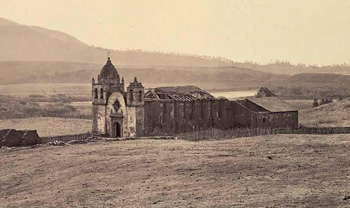
The abandoned Mission Carmel in 1876;
below, the stripped interior and collapsed roof
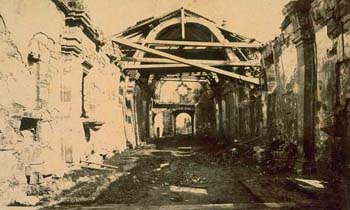 |
The mission period began to decline after Mexico declared its independence from Spain and the Mexican flag replaced the royal standard in the California Missions. The new Mexican government, Masonic in its roots, soon decided to close the Missions and sell their buildings and lands. In 1834 the Mexican government passed a decree of secularization authorizing civil confiscation of all the California Missions properties. On paper the Indians who lived in the Missions were supposed to be given first priority in purchasing the land. In fact, however, most was sold to new settlers and Mexicans who had fostered the Revolution.
Today the Revolution spreads the myth that the Indians suffered under the rule of the Church and Padres. The opposite is true. Before secularization, the Missions were extremely productive and the prosperous self-sufficient communities were flourishing. Daily life was active and ordered, divided between regular prayer time, work hours, rest and recreation. While discipline was strict, the Indians trusted the Friars who lived and labored among them, and knew they always worked for their best interests - both material and spiritual.
Under secularization, the Indians suffered a harsh fate. Both the Indians and Padres were forced off the land. The Indians often suffered brutal treatment at the hands of the land-hungry ranchers and miners, who had no concern for their well-being. Largely because of this bad treatment, between 1845 and 1880, the California Indian population plummeted from 150,000 to 20,400.
Abandonment & neglect
Under secularization, the lands of Mission San Carlos Borromeo were also partitioned and sold by the Mexican government. By 1836 the destruction of the Mission life was complete. The Mission lay abandoned and neglected; the church and the quadrangle of the presidio fell into ruin. The once fruitful land lay barren; the corrals that had herded thousands of cattle were broken down and tenantless.
In this period of neglect, the buildings were vandalized and many works of art stolen. What happened to the Virgin of Bethlehem during this time of pillage and havoc? The Statue was not listed in Mission Carmel's final post-secularization "auction" inventory in 1842. To save her from that humiliation, one of the last Mission resident Indian families, the Cantuas, had brought the Statue to their home for safekeeping. The Christ Child and crown along with other movable goods were taken to the Royal Presidio Chapel in Monterey.
Dona Maria Ignacia Dutra, a member of the Cantua family, became custodian of Our Lady of Bethlehem. When she moved to Monterey in 1876, she took the Statue with her. There were still many persons who wanted to pay homage to the Virgin, and they would visit her there, where she was enshrined wearing the wedding dress of Dona Maria.
Restoration
In 1846, California won its independence from Mexico and for two years called itself the Republic of California. In 1848 it became a territory of the United States, and two years later it became the 31st State of the Union. Only then, in 1859, were the Missions returned to the Catholic Church by the US government. For many of the churches, abandoned and in ruins, it was too late to save them.
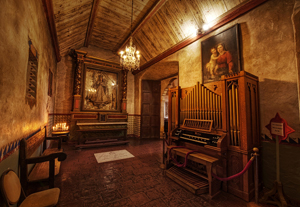
Our Lady behind glass in the poorly lit Mortuary Chapel; below, another statue set in front of her
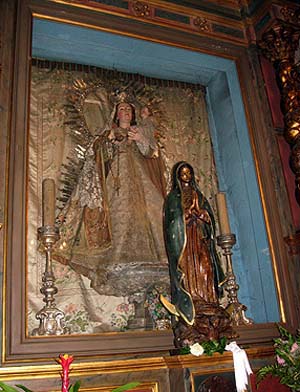 |
A happier outcome, however, awaited Mission San Carlos Borremeo. In 1882 the grave of Fr. Serra was found, which raised public interest in restoring the Mission, and a partial rebuilding project began. In 1933, Carmel Mission became a parish church, and the grand restoration began, due largely to the work of two men. One was parish priest Fr. Michael D. O'Connell; the other was a San Francisco cabinetmaker Harry W. Downie, who led the restoration project. Through exhaustive research, Downie made every effort to duplicate the original mission buildings with as much detail as possible. His work at Carmel Mission made San Carlos Borromeo Mission one of the most authentically restored missions of California.
During this period of reconstruction, a call was made to return items that had been in safekeeping by individuals and families for so many years. Before the Statue's first custodian, Maria Dutra, died in 1925, she had requested the Virgin of Bethlehem be given to Gertrude Ambrosia, a descendant of the one of the soldiers who had accompanied Fr. Serra on the Sacred Expedition. Now, Mrs. Ambrosia returned the Statue to Mission Carmel so that La Conquistadora would be restored to her proper place in its Chapel.
The Statue had survived the years of abandonment well. Only the wooden lower torso had to be replaced. She was dressed in a silver embroidered gown, a silk and gold brocade cope, and reunited with the original Christ Child and the original silver crown, still in storage at the Presidio Chapel - now known as the San Carlos Borromeo Cathedral of Monterey.
Newly vested and adorned, Our Lady of Bethlehem returned to her place of honor on the altar, in a niche on the new retablo. But when the restoration of the side Mortuary Chapel was completed, from some inexplicable decline in devotion, she was moved to that side chapel, a secondary place of relative obscurity. That Burial Chapel has no external light and is instead lit by a single set of votive and the hanging lamps. At times museum artifacts or other sacred art objects are placed in front of the historic Virgen de Belen. For curious tourists attracted by her beauty and charm, there is no data about her historic role and importance.
Although the mission today is restored and admired, one could say Our Lady of Bethlehem is still abandoned, waiting for a grand return of the love and devotion she properly merits.
"The ideal of consecrated motherhood"
On Mother's Day in the Marian year 1954, a solemn Pontifical was offered at Mission Carmel to honor the Statue of Our Lady of Bethlehem, "the first statue of Mary to be brought into the State." For one day, Our Lady returned to the limelight, placed under a canopy in the church square. During an evening candlelight ceremony, the Blessed Virgin Mary was declared "the ideal of consecrated motherhood... symbolized by the Statue of the Virgin of Belen." Then she was crowned "Madonna of the Expedition of 1769" with the silver crown and a garland of flowers.
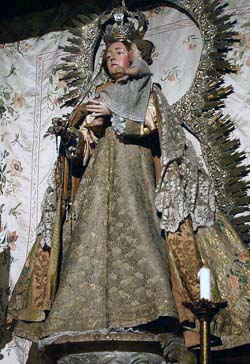
Our Lady of Bethlehem, richly adorned but set aside |
The Catholic papers of the time proudly record that more than 4,000 persons came to venerate her, pretending that this was a grand number of Catholics. In fact, it is a relatively small number when one considers the millions of Catholics in South America who honor their patron Virgins on feast days. In 2011 600,000 Brazilians traveled to the city of Aparecida to pay homage to Nossa Senhora Aparecida. Half a million Polish pilgrims travel to honor the Black Madonna, Queen of Poland, on each of the great Marian feast days.
In 1954, Catholics in California numbered close to 4 million. For only 4,000 to come out to greet the State's oldest Madonna is not significant. Today, there are more than 11 million Catholics in California, but the handful of pilgrimages to Our Lady of Bethlehem - hidden away in her obscure niche in the Mortuary Chapel - rarely number even 50 devotees. It is my hope that this series of articles will encourage more Catholics to come in greater numbers to visit her and pay her homage, raising a clamor to the careless religious authorities that she should be given a place of greater prominence.
Our Lady chose California to reign under a double invocation: Our Lady of Bethlehem and La Conquistadora. Both titles are rich in meaning. Clearly she wanted to appear as the Mother of Christ Child so that the Indians of California would realize her maternal warmth and goodness and have recourse to her in all their needs. She also wanted to be known as The Conqueror, the one who conquers all for Her Son. It seems that in the first plan of Providence for California, the people and the land were to be conquered for Christ through His Holy Mother. We can imagine the prosperity and graces this would have brought the State if this first appeal had been heard.
That original plan, however, was set off course by two avowed enemies of Our Lady, Mexican Freemasonry and American Protestantism. Because of the combined action of these two enemies, the Missions - and Our Lady of Bethlehem - faded into ruin and oblivion in the rush for gold.
Today, at this crossroads in History, it is time to return to the original plan of God for this State. One step along this path would be to make the Carmel Mission a site of pilgrimage to pay Our Lady of Bethlehem the homage she deserves. There we can plead with her to return California to a good path and to establish here the Reign of Mary that she promised. Under her maternal gaze, we can ask her to make each one of us, like those first heroic Franciscan missionaries, the apostles and builders of her Reign.
Continued
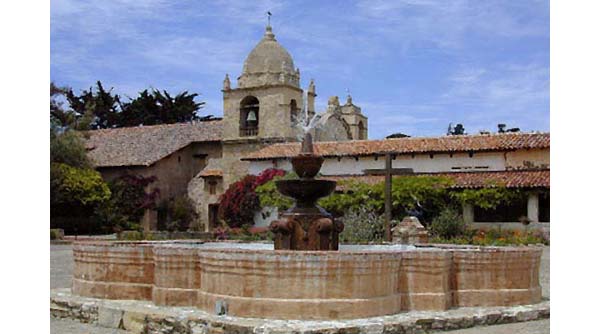
Today Carmel Mission is one of the most authentically restored Missions of California.
The fountain was returned when the call was made for the original dispersed artifacts |
1. Martin Morgado, Junípero Serra's Legacy, Pacific Grove, CA: Mount Carmel, 1987, p. 47
2. Edna E. Kimbro, Julia G. Costello, Tevvy Ball, The California Missions: History, Art, and Preservation, Getty Conservation Institute, 2009, p. 121
3. Morgado, Juípero Serra's Legacy, p. 49

Posted October 21, 2011

Related Topics of Interest
 Our Lady of Bethlehem: Her Adventure in America Our Lady of Bethlehem: Her Adventure in America
 Our Lady of Bethlehem Begins to Conquer California Our Lady of Bethlehem Begins to Conquer California
 Carmel Mission, Her Final Home & Junipero Serra Carmel Mission, Her Final Home & Junipero Serra
 Nossa Senhora Aparecida Nossa Senhora Aparecida
 Ven. Antonio Margil, Apostle of Texas Ven. Antonio Margil, Apostle of Texas
 La Conquistadora: Our Country's Oldest Madonna La Conquistadora: Our Country's Oldest Madonna
 The Burning of the Ursuline Convent in Charlestown The Burning of the Ursuline Convent in Charlestown
 Mary of Agreda in America Mary of Agreda in America

Related Works of Interest
|
|
History | Home | Books | CDs | Search | Contact Us | Donate

© 2002-
Tradition in Action, Inc. All Rights Reserved
|
 |
|